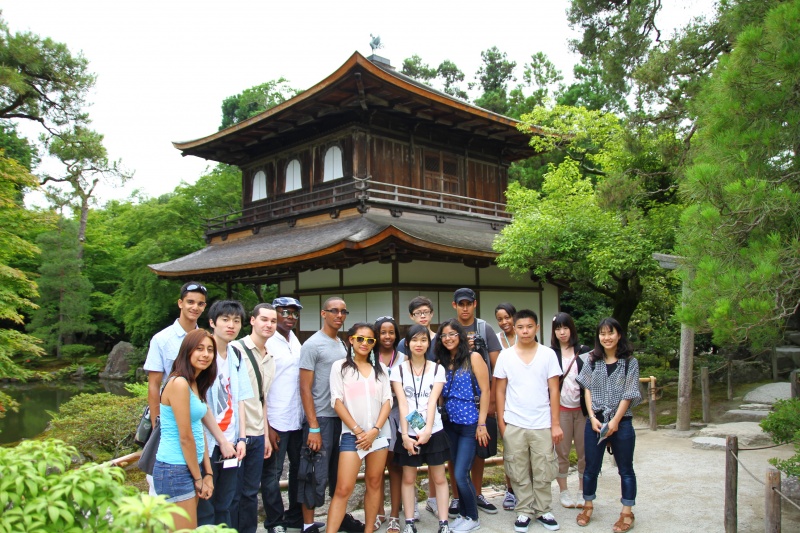
Mr. Bantz, East-West's Japanese Teacher writes on June 27, 2012:
Greetings from Kyoto!
Even though we just arrived in Japan last night, we set out this morning for our highly anticipated overnight trip to Kyoto.
We traveled by highway bus from Nagoya Station to Kyoto Station.
As we waited for our 8:40 AM bus, our students had their first chance to experience "konbini."
Japan has fostered a culture of convenience; people expect convenience stores to be nearby, always open, and stock appealing fresh food. Our students eagerly examined a large number of new and unfamiliar items in the 10 minutes that they had to shop. Some snacks purchased included a "Mystery of Love" flavor sour gummy candy, and a "Sweet Peanut Cream" sandwich (with crusts removed, of course).
The large windows on the bus gave us a beautiful view of bamboo forests and lush mountains on the way to Kyoto. Our students were heard commenting throughout the ride on the shape of the trees, the design of the highway and bridges, and the "Watch Out For Crossing Monkeys" sign.
After arriving at Kyoto Station, we checked into our hotel, dropped off our bags, and set off on our Kyoto tour. Our first stop was Nijoujou Castle. Our students learned about daimyo feudal lords visiting the shogun at this palace in Kyoto during feudal times. After visiting Nijoujou, we traveled to Kyoto University to have lunch at the student cafeteria. The university has a bustling campus, and the cafeteria offered an impressive variety of dishes at reasonable prices. Our students were slightly overwhelmed by all the choices, but everyone was able to decide on 1-2 dishes that appealed to them. Some of the dishes our students ordered were "katsukaree" (deep-fried pork chop in Japanese curry), soba and udon noodles, Chinese stir-fry with a "kick" (with meat, cabbage, and eggplant), and ramen with fried jumbo dumplings (gyoza) on top.
After lunch, we traveled to Ginkakuji Temple, the Silver Pavilion. The narrow road, just wide enough for a car to drive slowly through and avoid hitting pedestrians, is lined with shops selling local souvenirs and delicacies. Our students were impressed by their first Japanese temple. Students made observations about the design and landscaping of the temple grounds and admired the architecture and style of the temple itself.
We continued on to Kiyomizu-dera Temple, perched high in the hills of Kyoto. Our students were blown away by the unexpected panoramic views of the city and the temple approach below. Despite having a view of the entire city of Kyoto, Kiyomizudera has the atmosphere of a mountain retreat, with steep layers of trees and greenery surrounding the temple and its approach. The temple itself rests on a grid of thick wooden pilings built into the steep mountainside. The name "kiyomizu" means "purifying water." Many of our students enjoyed catching the natural spring water from the mountain into special cups and drinking it for health, beauty, and wellness. Our students also received their fortunes at the temple. Unfortunately, some of our students received "unlucky" fortunes and were encouraged by their fortunes to endure and wait for better times.
Returning down the temple approach road, our students did some brief souvenir shopping. The most popular stop was a Kyoto chopstick shop; some of our students purchased chopsticks and had their names engraved.
We made our final stop at Yasaka Jinja, a famous shrine in Kyoto. Many of our students took part in local customs, such as sending greetings at the shrine, and walking through a large circle shaped from rice stalks three times for a good harvest.
After arriving in Kyoto, all of our transportation was by local bus and on foot. Altogether, we took 6 (!) local buses in Kyoto today. Our students were advised about manners in Japan before the trip by our chaperones, and they proved today that they had been listening. Our students offered their seats to elderly passengers, were mindful of the volume of their conversations, and positioned themselves so as not to interrupt the flow of other passengers during the ride.
Needless to say, with so much activity after only 24 hours in Japan, our students were completely exhausted by the end of the day. We returned to the hotel for a light dinner and some much-needed down time. The students got a second wind and enjoyed trying on their "yukata," a cotton version of a kimono given by hotels as nightwear, and wearing their slippers around the hotel. Not surprisingly, the slippers were too small for nearly all our students and their feet hung out over the back, but our students flopped around happily. Three of our students are sharing a washitsuroom (Japanese-style room) with with tatami straw mats, real futon for sleeping, and traditional Japanese decor. This room is quite large for a Japanese room, and the other students decided to congregate there and make it the "hang-out room" until room check. All students are now sleeping soundly.

Here are some pictures from our first full day in Japan. Tomorrow will be another full day of sightseeing in Kyoto and we will return to Nagoya in time for students to have dinner with their host families.
More to come tomorrow!
View more photos from their trip! This album will continually update during their 9 day stay in Japan.
Kyoto Day 2
Greetings from Nagoya!
We have returned from our Kyoto trip and all students are back at home with their host families in Nagoya.
We started our day with a 7 AM wake-up call to find that most of our students were already wide awake, dressed, and ready to go out! Sunrise in Kyoto today was officially 4:45 AM (!). Between the jet lag, unfamiliar surroundings, and early sunrise, our students were ready to head out earlier than expected.
Most of our students tried "asa Makku" for breakfast. "Asa Makku" is a very popular Japanese breakfast that can be translated into English as "breakfast at McDonald's." Our students took turns ordering their "setto" (value meals, derived from the English 'set'). Our students ordered on the ground floor and brought their food down to the lower level, where signs posted advertised comfortable seating for 120 people. Our students experienced culture shock as they arrived at the lower level; more than half of the 120 seats were taken by McDonald's customers, but the dining area was quieter than a library and only faint elevator music filled the air. Our students arranged themselves in one seating area where they all fit and started to whisper to each other. It was quite a sight for our chaperones to see 13 East-West high school students whispering to each other over breakfast at McDonald's in Kyoto. As our students finished their meals, they quietly got up and gently pushed in their chairs before throwing away their trash, as if not to wake a sleeping roommate. We never thought to bring the cameras to breakfast-- what a mistake!
We began our sightseeing by heading to Kinkakuji, the Golden Pavilion. Some of you may have seen the large picture of Kinkakuji posted in the hallway outside room 434 at East-West. It is quite literally a temple building that is "gold foil on lacquer," consisting of three levels, each done in a different architectural style to create a single cohesive structure. The entire structure juts out into a large pond where jumbo carp share the water with turtles and, on this day, a lone crane. Our students were impressed by the design and landscaping of the temple grounds; as our students progressed through the path that leads around the temple, each potential view and photo seemed picture perfect. It is difficult to describe in words the distinct quality of immaculately manicured shrubs and trees, each with their own character and imperfections, coming together in seemingly random ways to perfectly complement the man-made Golden Pavilion.
On the way back to the bus, many of our students took a break to sample "melon soda." Melon soda is a perennial favorite of Japanese small children, akin to chocolate milk for American children. Our students ordered from a fountain drink vending machine that dispenses a cup, adds ice, and then fills it with soft drink.
We continued on to Arashiyama, an area of Kyoto known for scenic landscapes and an atmosphere reminiscent of past generations. We took a one-car train that runs on a single track; trains run in both directions on one track but can only pass each other on either side of the platform while stopped at a station.
After visiting Arashiyama, our students were ready for the bus ride back to Nagoya. We did some final souvenir shopping, headed back to Kyoto proper, and boarded our bus back to Nagoya.
Our students have not yet been able to distinguish between what is specific to Kyoto, what is typical of Nagoya, and what is representative of Japan. For example, in Kyoto, buses have two doors, just like New York buses do. However, in Kyoto, passengers board from the rear door and then pay as they exit the bus from the front door. Some of our students were heard commenting how unusual that "in Japan" people board from the back of the bus. We pointed out to our students that, even "in Japan," this was not the norm, but is one part of local Kyoto culture.
Our students are now re-connecting with their host families. This is an awkward time for many; all students and their families are eager to get to know each other, yet are forced to socialize in an intimate setting with someone they have just met. Our students and their families still need time to move past their own idealized pre-conceptions of each other and take time to actually get to know each other. Our previous student participants have shown that this process is extremely rewarding in the long term.
Tomorrow we will travel to Nagahama to have a traditional Japanese music instrument lesson, followed by a tea ceremony session.
View more photos from their trip! This album will continually update during their 9 day stay in Japan.
Nagahama Day Trip
Today we took a one-day trip to Nagahama, in Shiga Prefecture.
Our students experienced leisurely Japanese train travel. Seats in our trains were arranged in rows of 2, all facing the same direction (similar to seats on Metro North or the Long Island Railroad). Our students had a jaw-dropping moment, however, when they discovered that the seat back of each row could be effortlessly rolled over the seat to face the opposite direction. If you haven't seen it before, you may not even understand what I have just described.
We traveled by train to Nagahama, an old Japanese town situated on Lake Biwa (Biwako), one of Japan's largest and most famous lakes. We had lunch at a local restaurant recommended by our hosts, Mr. and Mrs. Tanaka. The Tanakas are teachers of traditional Japanese music instruments. They are the parents of Mr. Masahiro Tanaka, a Japanese language teacher who began his career at East-West before moving on to teach native Japanese language arts at the United States International School.
After a short walking tour of the town's main sites, we proceeded to a lakeside public hall for our music lesson and tea ceremony. Our students received individualized instruction from 4 teachers. Each student was able to pluck the right strings to play perhaps the best know traditional Japanese melody, Sakura.


The music lesson was followed by a tea ceremony demonstration. Our students tried very hard to maintain seiza, the formal Japanese sitting position in which one rests on one's knees and ankles. Our students enjoyed learning the different steps of the tea ceremony, even though the weather was not conducive to eating traditional Japanese sweets followed by drinking rich and bitter Japanese green tea. Today was actually our first true sunny summer day; until now, we have had mostly cloudy days where rain seemed imminent but did not fall. After the tea ceremony, all students were in good spirits and re-energized after a short rest and cold water with electrolytes. All are doing well.
The rest of the day had a more leisurely pace; we took a short walk by Lake Biwa, which looked like a perfect blue ocean with green mountains in the background. We took our time returning to Nagoya and all students are now safely with their host families.
Please enjoy pictures from today's activities. Many thanks to the East-West adminstrators, staff members, family members, and coach who have been following our daily updates and have responded with positive feedback.
Warm Regards,
David
View more photos from their trip! This album will continually update during their 9 day stay in Japan.
Family Day
Today was a very long day for our group. We traveled by train to Ise Shrine, one of the most historically significant in Japan.
Upon returning to Nagoya, we headed to a local theater for a local theater production starring one of Noriko's former students who has visited East-West in the past and helped host our students in Japan before.
The heat, humidity, and tough schedule caught up with our kids tonight. The theater was very crowded and uncomfortable, so part of our group left the theater with Ms. Warren and Mr. Shibata to recuperate before returning home. The students who stayed till the end of the show enjoyed the production, an avant garde Japanese/Western hybrid play/musical.
With our late return, we ended up sending some of our students home exhausted tonight. We have modified the schedule for tomorrow. We have cancelled the morning visit to Inuyama to give our students a later start. Students whose host families do not have work or outside appointments will stay home with their host families to rest until lunchtime. Others will meet with us at a modified start time of 9:30 AM and will stay in Nagoya's underground malls, out of the sun. We will continue our regularly scheduled activities at 1:30 PM when we arrive for our visit at Nishiharu High School. This modified schedule will help our students rest up and get their strength back for their return flight home.
Our trip is winding down and our students are joking about accidentally being "left behind" because they are enjoying Japan so much. We look forward to seeing how our students build on the experience gained here, in school, at home, and in life. We hope that these students will be able to share their experiences with the entire school body in a visible way to give others who were not able to come a glimpse into life in Japan and how inter-cultural exchange can change lives. This should also motivate other students who need a larger goal to strive for as they move through their high school careers.
Here are some photos for today.
Best,
David Bantz
Here is a short report from our final day in Japan.
Half of our group visited Inuyama Castle on a very rainy day (the other half stayed home with their host families resting).
The entire group then visited Nishiharu High School. Our students were impressed by the physical education classes and club activities they observed. 5 large groups of high school seniors were working on separate tasks under the supervision of 2 physical education teachers, all sharing the same space. One teacher worked on dancing, the other on acrobatic tricks. Our students also observed English and Math lessons. The content of the lessons was of a very high level, and the classes were conducted in a lecture style in which no teacher was observed more than 2 feet from the blackboard. Teachers did not circulate around the room or look at the students' work during the lesson; students were responsible for checking and correcting their own work. In fact, there was no student work posted anywhere in the school that we could see except for the art room, which had student paintings on display. Despite the standard class size of 40 students, the Japanese students displayed focus and discipline despite the stifling heat and humidity.
In Japanese schools at all levels, students form groups and clean the entire school. Every student cleans; each group is responsible for a different area of the classroom or school building, and groups rotate cleaning assignments throughout the year. We had to wait for daily cleaning time to finish in order to start our meet-and-greet session. The principal asked if any of our students wanted to help the Japanese students clean and many of our students jumped straight out of their seats and went to receive instructions from the Japanese students who had just started cleaning. Unsurprisingly, taking ownership of cleaning allows students to be more invested in their schools. Consequently, there was very little mess to clean. This is in stark contrast to the end of the day at a typical New York City public school, where litter can often be found on classroom floors, trash piles out of cans, and desks are at times left filled with candy wrappers and gum.
Our visit closed with a meet-and-greet session of 37 students who stayed after school to interact with our 13 East-West ambassadors. Our students prepared questions to ask their Japanese counterparts in advance. We left the youngsters to themselves and watched as all participants came out of their shells and mixed Japanese and English to talk about their hobbies, interests, and daily life in each other's countries. The session was invaluable for all participants and we hope to build a relationship with Nishiharu High School.
Enjoy this last set of photos.
It was a true joy to accompany our 13 students to Japan. They represented themselves, our school, and our country well. We should all be proud.
Have a healthy and fulfilling summer.
Best,
David Bantz

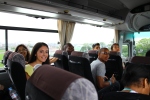


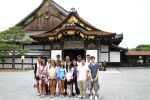

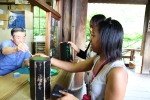











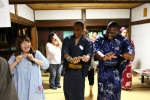



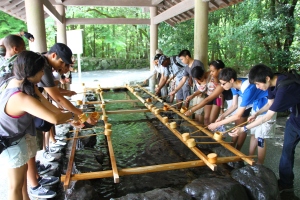
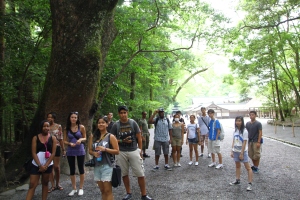
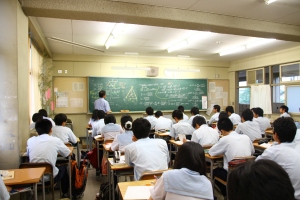
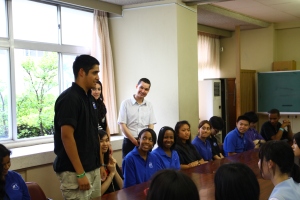
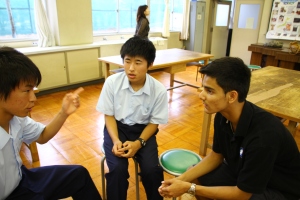
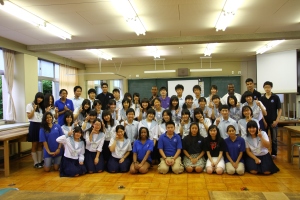
Comments
Emmie Escobar (not verified) - July 4, 2012 - 1:54am
Dear David,
Thank you for coordinating such a wonderful trip for our children. All of the students looked like they were having a great time in Japan. Having the opportunity to travel to a different country and learn about their culture will be with them forever. And will prove to be an invaluable experience. We're sure that they will keep these memories in their hearts and be able to share them with friends and future generations (their own children).
Thank you for keeping our kids safe, and for keeping us updated as to what activities they were doing. It could not have been an easy task; but you managed to us informed.
Without all of your efforts, none of this would have been possible.
Thank you again!
Sincerely,
Bob & Emmie